MITSUBISHI 3000GT 1991 Service Manual
Manufacturer: MITSUBISHI, Model Year: 1991, Model line: 3000GT, Model: MITSUBISHI 3000GT 1991Pages: 1146, PDF Size: 76.68 MB
Page 111 of 1146
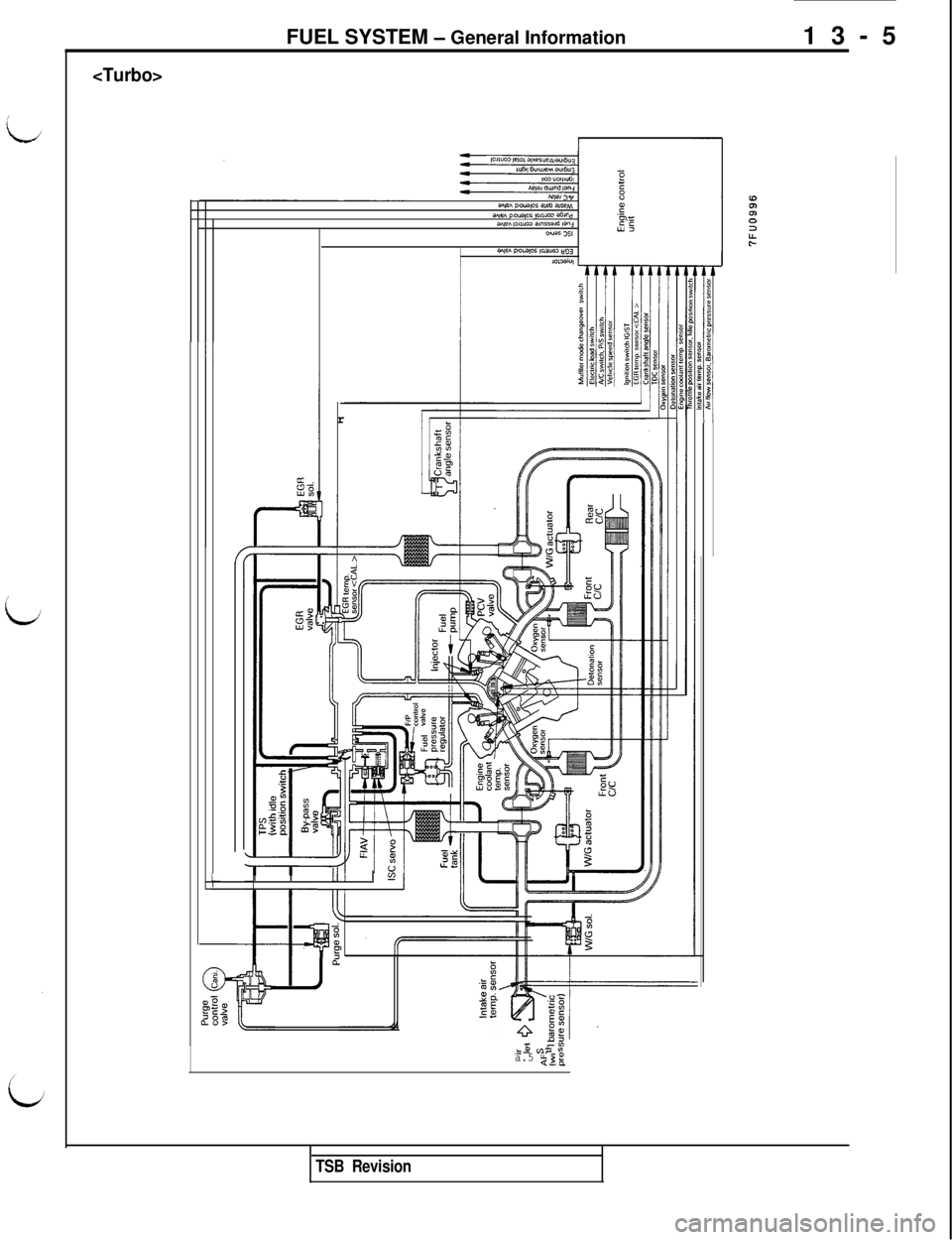
FUEL SYSTEM - General Information
13-5
,-=c1 ,ivYan,w p1oYa,os am aSeMawn ploqor ,Oli”OJ aE%:an,en,Oll”OJ amrsa>* WI,‘6.XONar 3SIiI=5
i-
an,en plo”apn ,Ol,“rn 833
r
IIIII III 1
II
I J
b
-ti.=z wf aa.5 239
B5:
::KplyPB
I
I,$L1 gE:;I$$I:
TSB Revision
Page 112 of 1146
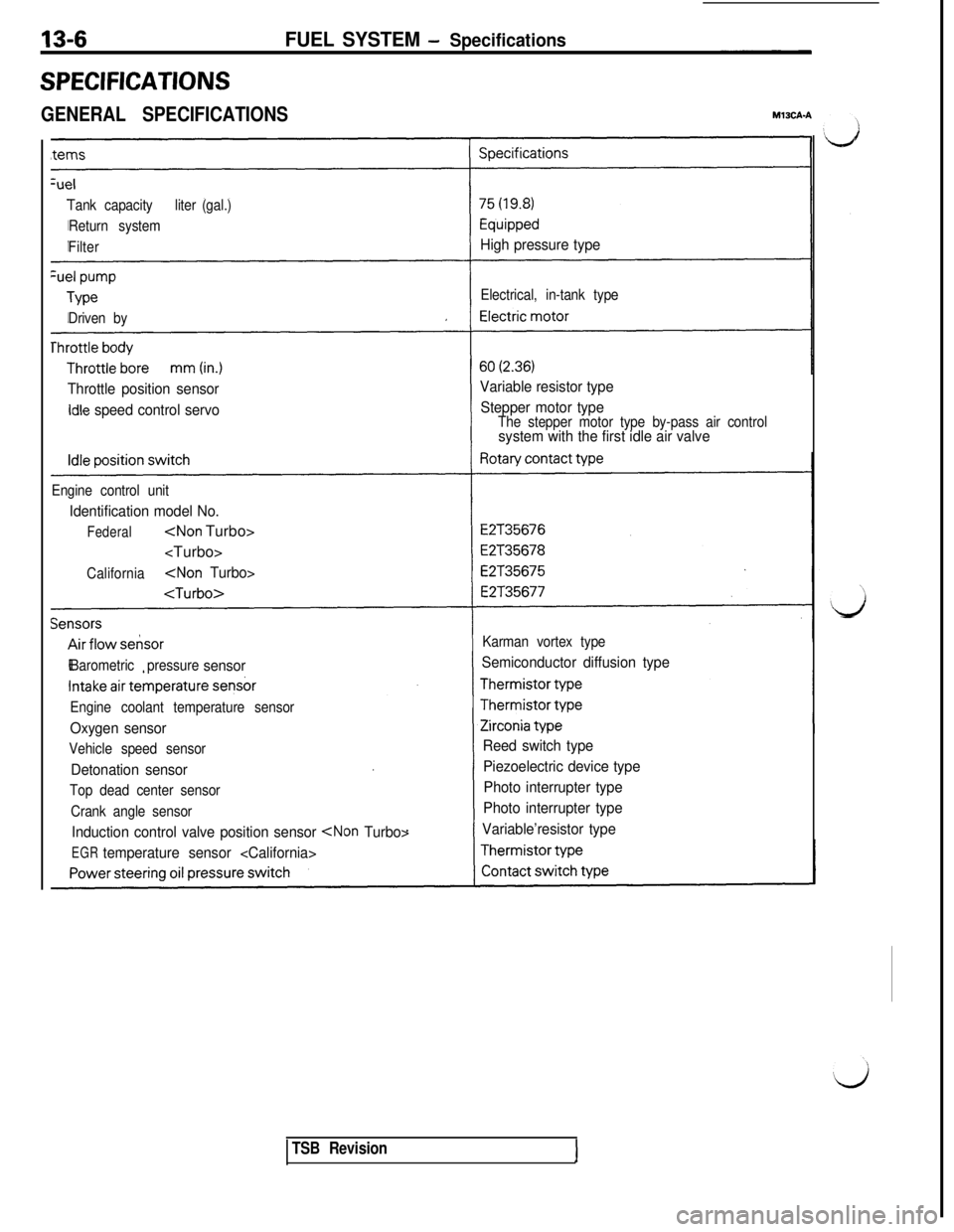
Tank capacityliter (gal.)
Return system
Filter
High pressure type
Electrical, in-tank type
Driven by
Throttle position sensor
idle speed control servoVariable resistor type
Stepper motor typeThe stepper motor type by-pass air controlsystem with the first idle air valve
Engine control unit
Identification model No.
Federal
California
Karman vortex type
Barometric pressure
sensorSemiconductor diffusion type
Engine coolant temperature sensor
Oxygen sensor
Vehicle speed sensor
Detonation sensor
Top dead center sensor
Crank angle sensor
Induction control valve position sensor
EGRtemperature sensor
Piezoelectric device type
Photo interrupter type
Photo interrupter type
Variable’resistor type
13-6FUEL SYSTEM - Specifications
SPECIFICATIONS
GENERAL SPECIFICATIONS
TSB Revision
Page 113 of 1146
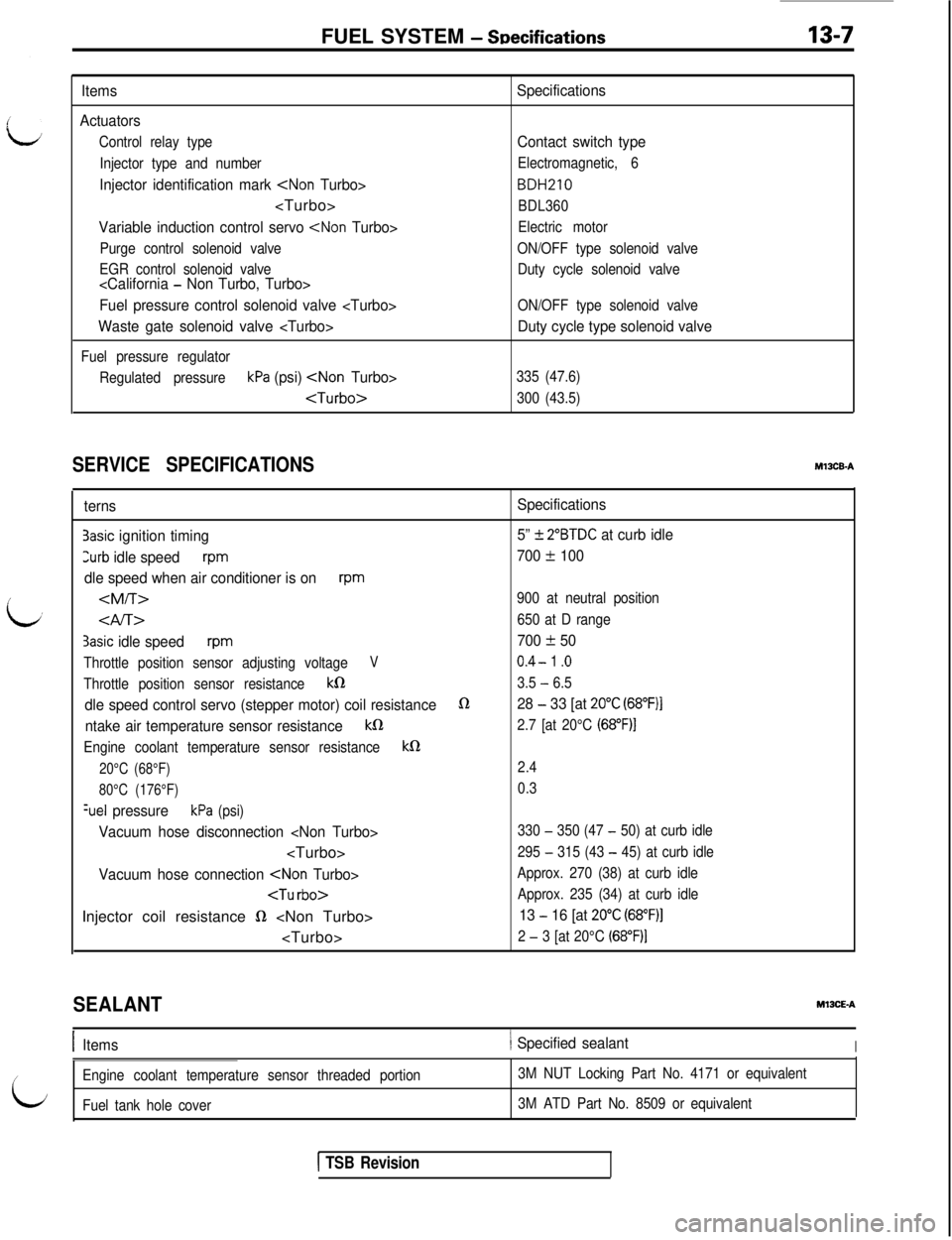
FUEL SYSTEM - SDecifications
L
Items
Actuators
Control relay type
Injector type and number
Injector identification mark
Variable induction control servo
Purge control solenoid valve
EGR control solenoid valve
Fuel pressure control solenoid valve
Waste gate solenoid valve
Fuel pressure regulator
Regulated pressure
kPa (psi)
Specifications
Contact switch type
Electromagnetic, 6
BDH210
BDL360
Electric motor
ON/OFF type solenoid valve
Duty cycle solenoid valve
ON/OFF type solenoid valve
Duty cycle type solenoid valve
335 (47.6)
300 (43.5)
SERVICE SPECIFICATIONS
i
ternsSpecifications
3asic ignition timing5” -t 2”BTDC at curb idle
3urb idle speedrpm700 * 100
dle speed when air conditioner is on
rpm
3asic idle speedrpm700 + 50
Throttle position sensor adjusting voltageV0.4- 1 .o
Throttle position sensor resistancek03.5 - 6.5
dle speed control servo (stepper motor) coil resistance028 - 33 [at 20°C (68”F)I
ntake air temperature sensor resistancekfi2.7 [at 20°C (68”F)I
Engine coolant temperature sensor resistancekQ
20°C (68°F)
2.4
80°C (176°F)0.3
%el pressurekPa (psi)
Vacuum hose disconnection
295 - 315 (43 - 45) at curb idle
Vacuum hose connection
Sz
2 - 3 [at 20°C (68”F)I
SEALANTMlXE-A
IItems1 Specified sealantI
/
L
Engine coolant temperature sensor threaded portion3M NUT Locking Part No. 4171 or equivalent
Fuel tank hole cover3M ATD Part No. 8509 or equivalent
1 TSB Revision
Page 114 of 1146
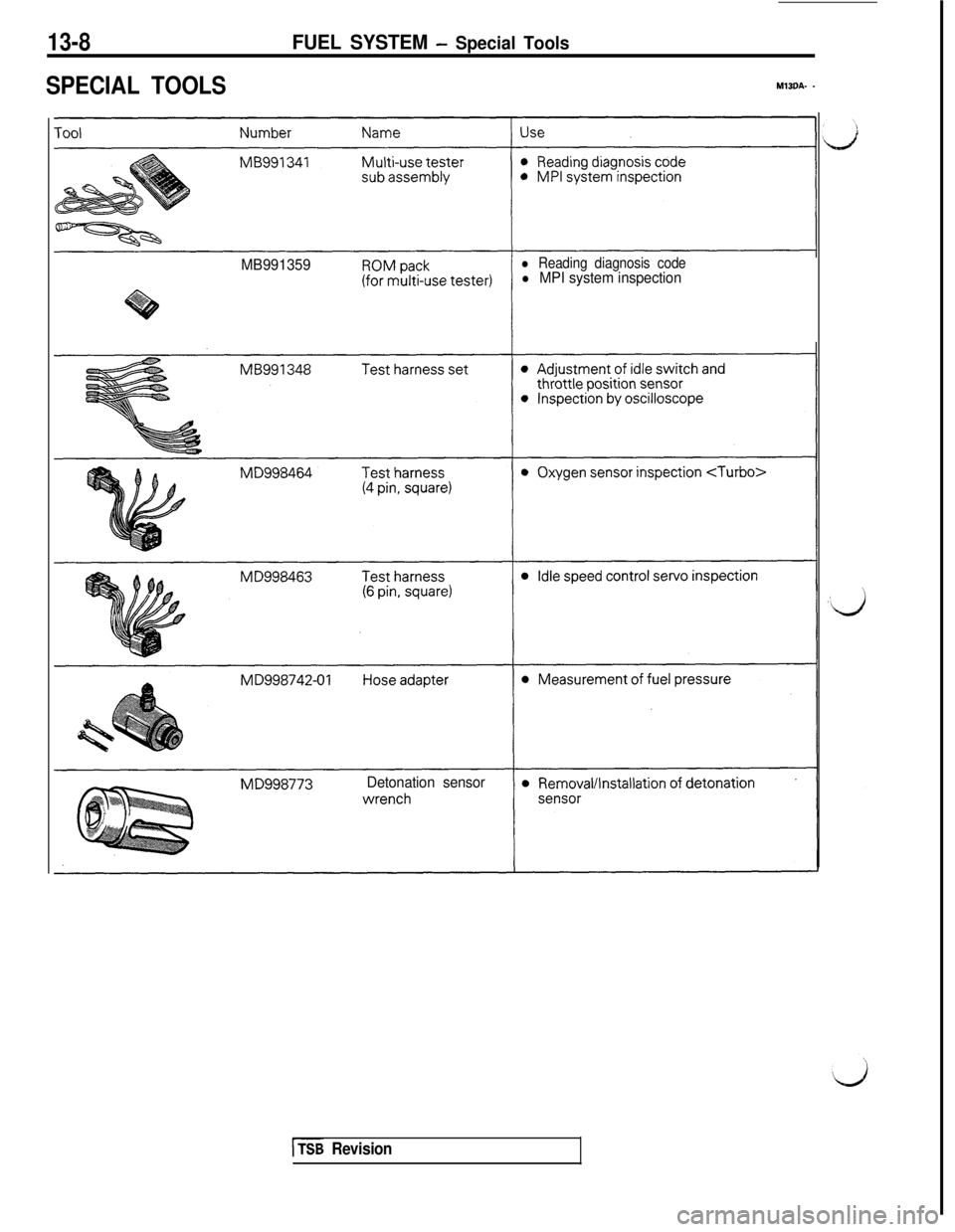
13-8
SPECIAL TOOLS
FUEL SYSTEM - Special Tools
MlBDA- -
MB991359l Reading diagnosis codel MPI system inspection
Detonation sensor
[TSB Revision
Page 115 of 1146
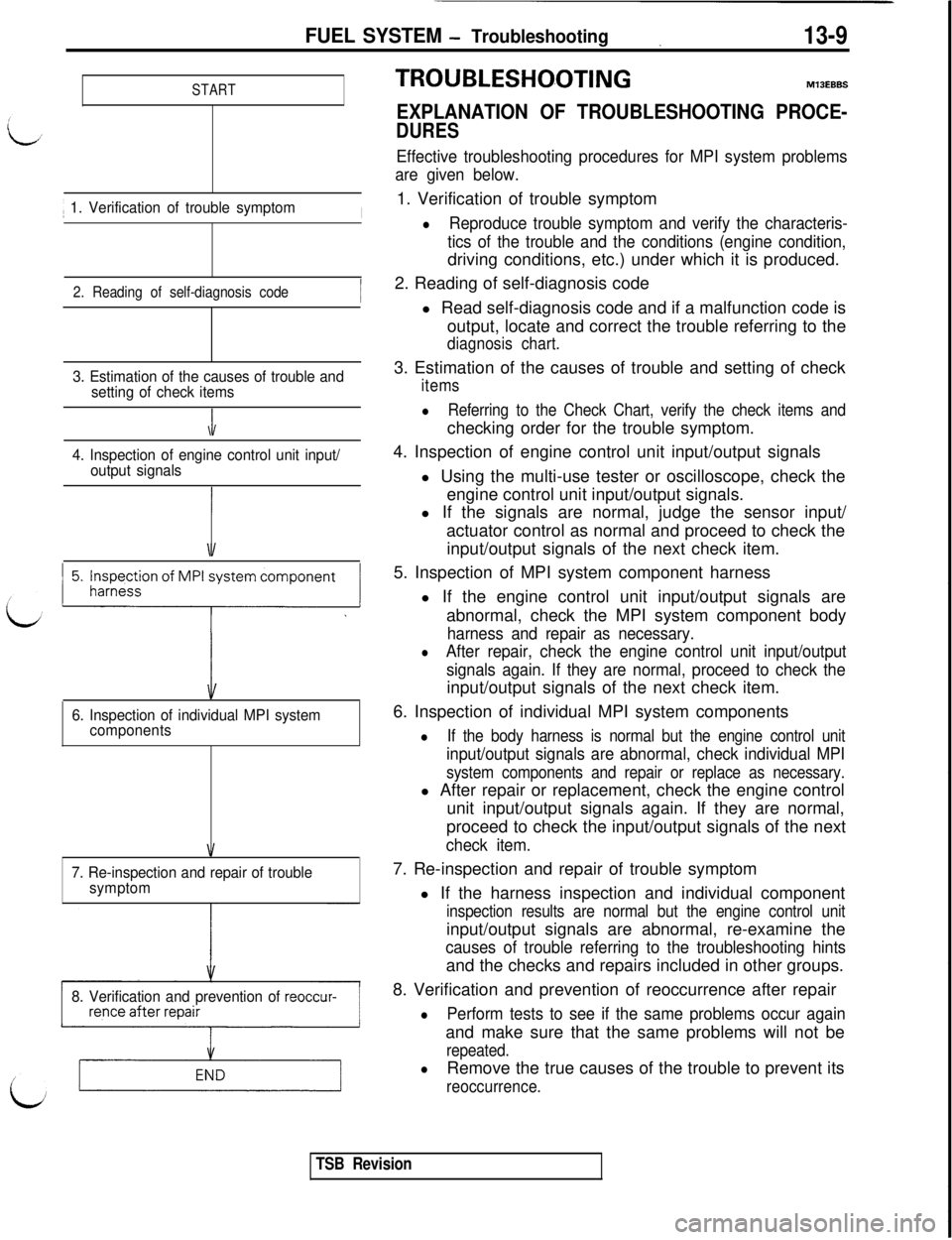
FUEL SYSTEM - Troubleshooting13-9
START1
1. Verification of trouble symptomI
2. Reading of self-diagnosis code
3. Estimation of the causes of trouble and
setting of check items
\1
4. Inspection of engine control unit input/
output signals
\1
5. Inspection of MPI system component
LL
6. Inspection of individual MPI system
components
7. Re-inspection and repair of trouble
symptom
8. Verification and prevention of
reoccur-
TROUBLESHO.OTlNGMlBEBBS
EXPLANATION OF TROUBLESHOOTING PROCE-
DURES
Effective troubleshooting procedures for MPI system problems
are given below.1. Verification of trouble symptom
lReproduce trouble symptom and verify the characteris-
tics of the trouble and the conditions (engine condition,driving conditions, etc.) under which it is produced.
2. Reading of self-diagnosis code
l Read self-diagnosis code and if a malfunction code is
output, locate and correct the trouble referring to the
diagnosis chart.3. Estimation of the causes of trouble and setting of check
items
lReferring to the Check Chart, verify the check items andchecking order for the trouble symptom.
4. Inspection of engine control unit input/output signals
l Using the multi-use tester or oscilloscope, check the
engine control unit input/output signals.
l If the signals are normal, judge the sensor input/
actuator control as normal and proceed to check the
input/output signals of the next check item.
5. Inspection of MPI system component harness
l If the engine control unit input/output signals are
abnormal, check the MPI system component body
harness and repair as necessary.
lAfter repair, check the engine control unit input/output
signals again. If they are normal, proceed to check theinput/output signals of the next check item.
6. Inspection of individual MPI system components
lIf the body harness is normal but the engine control unit
input/output signals are abnormal, check individual MPI
system components and repair or replace as necessary.l After repair or replacement, check the engine control
unit input/output signals again. If they are normal,
proceed to check the input/output signals of the next
check item.7. Re-inspection and repair of trouble symptom
l If the harness inspection and individual component
inspection results are normal but the engine control unitinput/output signals are abnormal, re-examine the
causes of trouble referring to the troubleshooting hintsand the checks and repairs included in other groups.
8. Verification and prevention of reoccurrence after repair
lPerform tests to see if the same problems occur againand make sure that the same problems will not be
repeated.
lRemove the true causes of the trouble to prevent its
reoccurrence.
TSB Revision
Page 116 of 1146
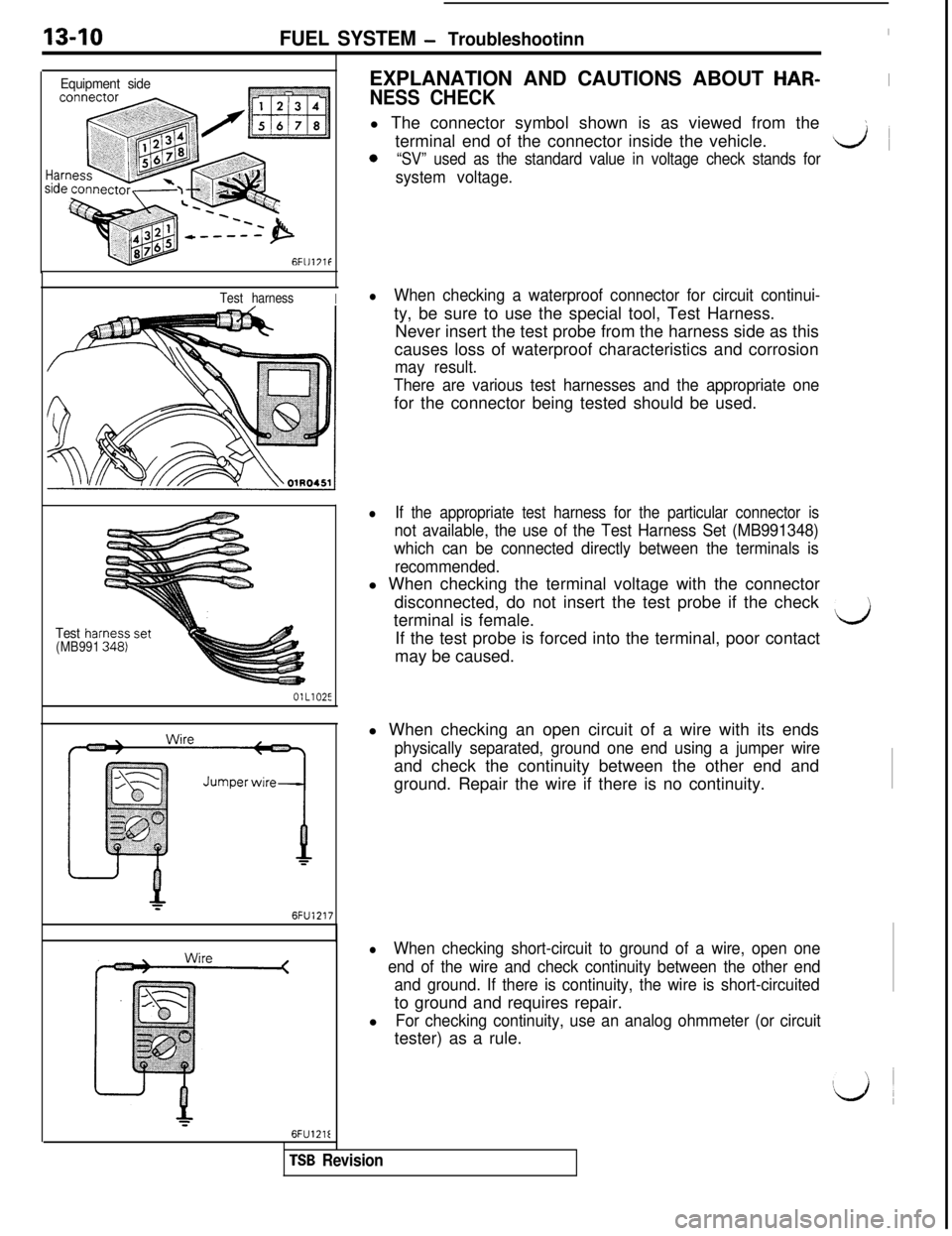
13-10FUEL SYSTEM - Troubleshootinn
Equipment side
Hasid
6Fl1171f
Test harnessI
Test hai(MB991OlL102E
6FU1217
NESS CHECKl The connector symbol shown is as viewed from the
Iterminal end of the connector inside the vehicle.
ij~0“SV” used as the standard value in voltage check stands for
system voltage.
lWhen checking a waterproof connector for circuit continui-ty, be sure to use the special tool, Test Harness.
Never insert the test probe from the harness side as this
causes loss of waterproof characteristics and corrosion
may result.
There are various test harnesses and the appropriate onefor the connector being tested should be used.
lIf the appropriate test harness for the particular connector is
not available, the use of the Test Harness Set (MB991348)
which can be connected directly between the terminals is
recommended.l When checking the terminal voltage with the connector
disconnected, do not insert the test probe if the check
terminal is female.
dIf the test probe is forced into the terminal, poor contact
may be caused.
l When checking an open circuit of a wire with its ends
physically separated, ground one end using a jumper wireand check the continuity between the other end and
ground. Repair the wire if there is no continuity.
lWhen checking short-circuit to ground of a wire, open one
end of the wire and check continuity between the other end
and ground. If there is continuity, the wire is short-circuitedto ground and requires repair.
l
For checking continuity, use an analog ohmmeter (or circuittester) as a rule.
TSB Revision
Page 117 of 1146
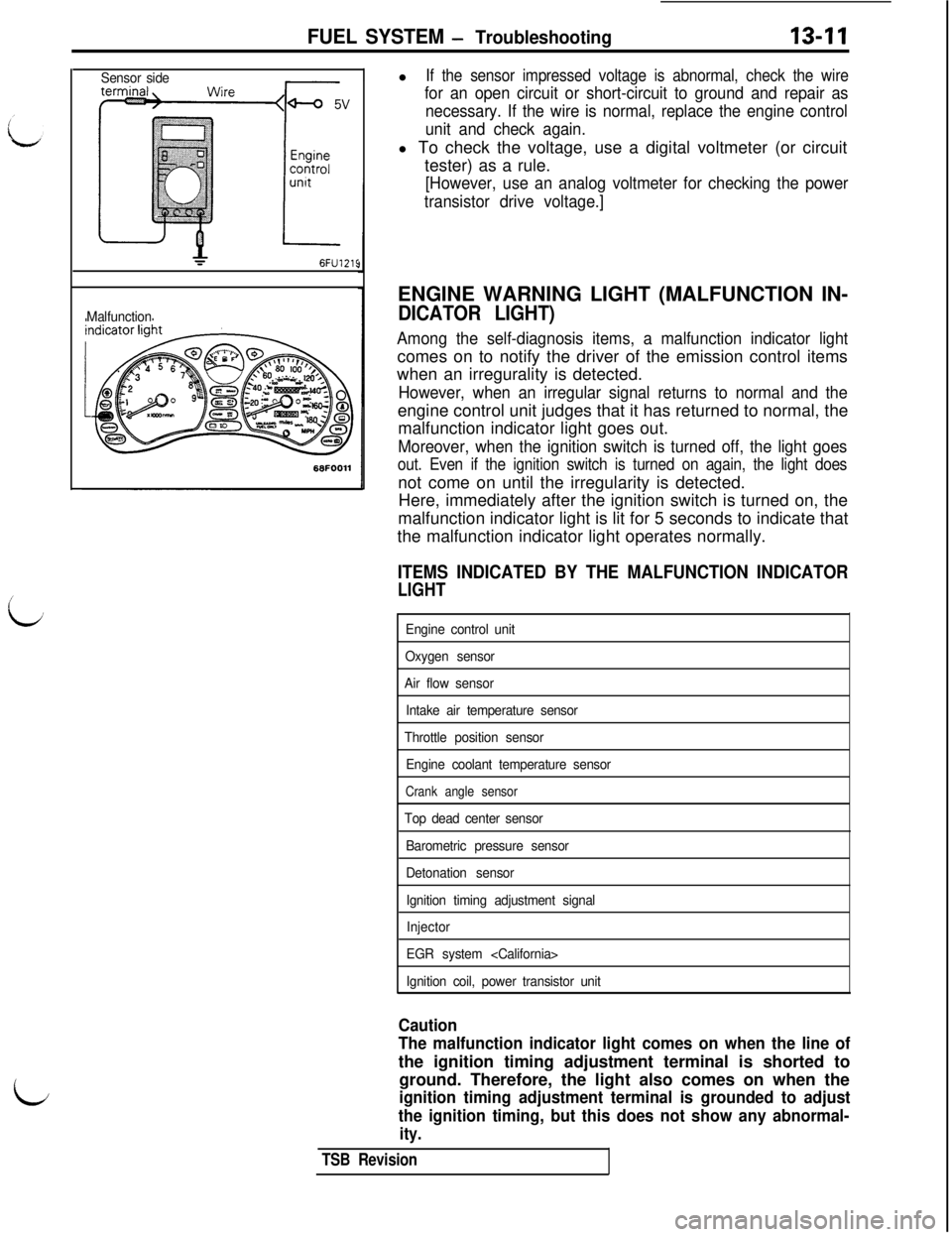
FUEL SYSTEM - Troubleshooting13-11
L
L
Sensor side6FU1215
Malfunctionl
If the sensor impressed voltage is abnormal, check the wire
for an open circuit or short-circuit to ground and repair as
necessary. If the wire is normal, replace the engine control
unit and check again.l To check the voltage, use a digital voltmeter (or circuit
tester) as a rule.
[However, use an analog voltmeter for checking the power
transistor drive voltage.]ENGINE WARNING LIGHT (MALFUNCTION IN-
DICATOR LIGHT)
Among the self-diagnosis items, a malfunction indicator lightcomes on to notify the driver of the emission control items
when an irregurality is detected.
However, when an irregular signal returns to normal and theengine control unit judges that it has returned to normal, the
malfunction indicator light goes out.
Moreover, when the ignition switch is turned off, the light goes
out. Even if the ignition switch is turned on again, the light doesnot come on until the irregularity is detected.
Here, immediately after the ignition switch is turned on, the
malfunction indicator light is lit for 5 seconds to indicate that
the malfunction indicator light operates normally.
ITEMS INDICATED BY THE MALFUNCTION INDICATOR
LIGHT
Engine control unit
Oxygen sensor
Air flow sensor
Intake air temperature sensor
Throttle position sensor
Engine coolant temperature sensor
Crank angle sensor
Top dead center sensor
Barometric pressure sensor
Detonation sensor
Ignition timing adjustment signal
Injector
EGR system
Ignition coil, power transistor unit
Caution
The malfunction indicator light comes on when the line ofthe ignition timing adjustment terminal is shorted to
ground. Therefore, the light also comes on when the
ignition timing adjustment terminal is grounded to adjust
the ignition timing, but this does not show any abnormal-
ity.
TSB Revision
Page 118 of 1146

13-12FUEL SYSTEM - Troubleshooting
MALFUNCTION INDICATOR LIGHT INSPECTION
(1) Check that when the ignition switch is turned on, the lightilluminates for about 5 seconds and then goes out.
(2) If the light does not illuminate, check for open circuit in
dharness, blown fuse and blown bulb.
SELF-DIAGNOSIS
The engine control unit monitors the input/output signals (some
signals at all times and the others under specified conditions) ofthe engine control unit.
When it is noticed that an irregularity has continued for a
specified time or longer from when the irregular signal is
initially monitored, passing a certain number, the engine controlunit judges that an irregularity has occurred, memorizes the
malfunction code, and outputs the signal to the self-diagnosis
output terminal.
There are 21 diagnosis items, including the normal state, andthe diagnosis results can be read out with a voltmeter or
multi-use tester.Moreover, since memorization of the malfunction codes is
backed up directly by the battery, the diagnosis results are
memorized even if the ignition key is turned off. The malfunc-
tion codes will, however, be erased when the battery terminalor the engine control unit connector is disconnected.
The malfunction code can also be erased by turning on the
ignition switch and sending the malfunction code erase signalfrom the multi-use tester to the engine control unit.
CautionIf the sensor connector is disconnected with the ignition
_ _switch turned on, the malfunction code is memorized. Ind
this case, send the malfunction code erase signal from themulti-use tester to the engine control unit or disconnect
the battery terminal
(-) for 10 seconds or more, and the
diagnosis memory will be erased.
The 21 diagnosis items are provided as follows, and if plural
items are activated, they are all indicated sequentially from the
smallest code number.
CautionThe malfunction code for the ignition timing adjustment
signal is output when the line of the ignition timing
adjustment terminal is shorted to ground. Therefore, the
malfunction code is also output when the ignition timing
adjustment terminal is grounded to adjust the ignition
timing, but this does not show any abnormality.
TSB Revision
Page 119 of 1146
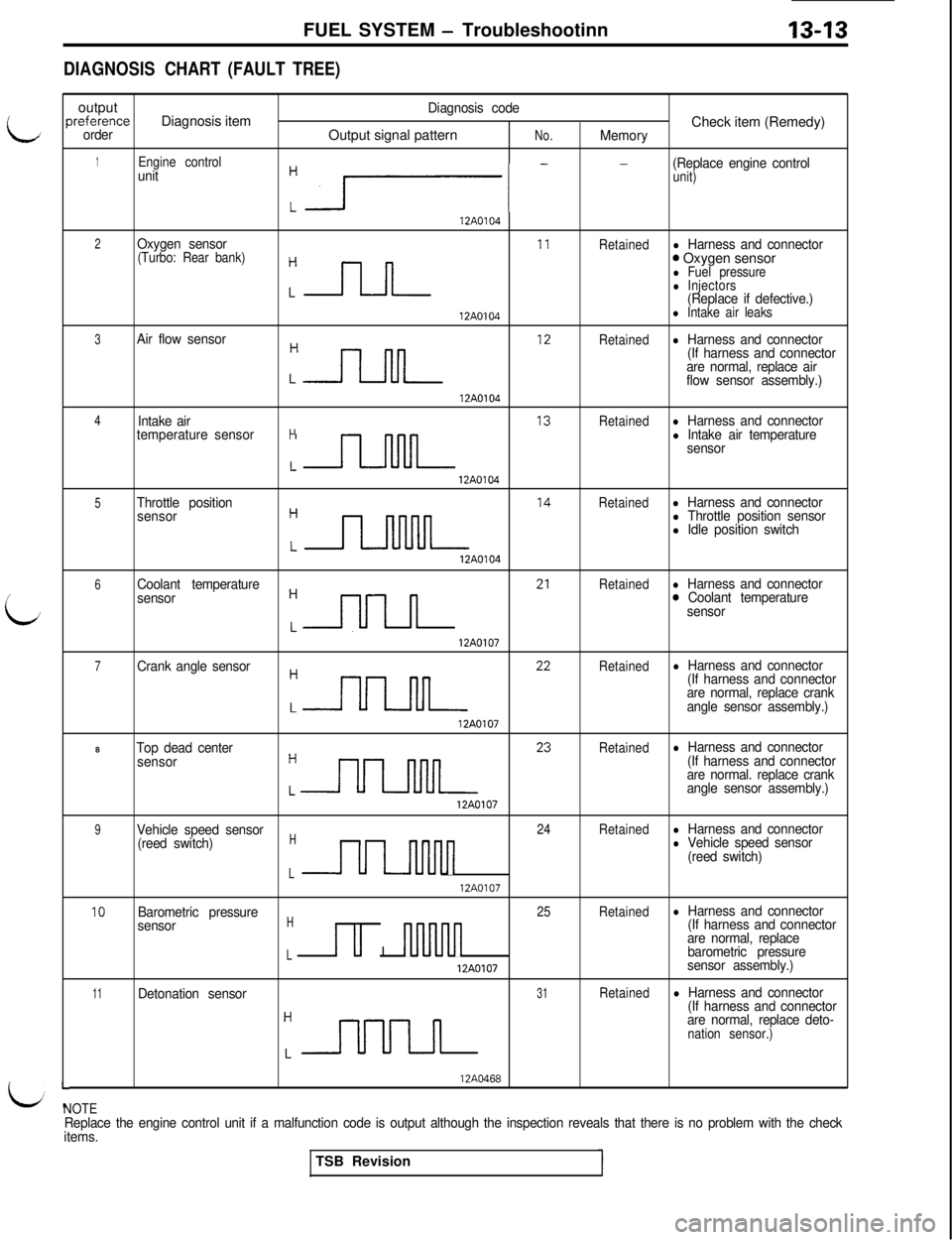
FUEL SYSTEM - Troubleshootinn
DIAGNOSISCHART (FAULT TREE)
i
L
Foutput
Diagnosis codeIreferenceDiagnosis item
Check item (Remedy)orderOutput signal patternNo.Memory
1Engine controlunit
:r- -
(Replace engine controlunit)
12A0104
2Oxygen sensorRetainedl Harness and connector(Turbo: Rear bank)
Cnn I’
0 Oxygen sensorl Fuel pressurel Injectors(Replace if defective.)
12A0104l Intake air leaks
3Air flow sensor
:n ‘*
Retainedl Harness and connector
(If harness and connector
are normal, replace air
flow sensor assembly.)
12A0104
4Intake airRetainedl Harness and connector
temperature sensorH
Ln I3
l Intake air temperature
sensor
12A0104
5Throttle position
sensor
:n I4
Retainedl Harness and connectorl Throttle position sensorl Idle position switch
12AO104
6Coolant temperature
:nn 21
Retainedl Harness and connector
sensor0 Coolant temperature
sensor12A0107
7Crank angle sensor
:nn 22
Retainedl Harness and connector
(If harness and connector
are normal, replace crank
angle sensor assembly.)
12A01078
Top dead centerRetainedl Harness and connector
sensor
:nn 23
(If harness and connector
are normal. replace crank
angle sensor assembly.)
12A0107
9Vehicle speed sensor24Retainedl Harness and connector
(reed switch)H
UInnnn
l Vehicle speed sensor
(reed switch)
L12A0107
10Barometric pressure25Retainedl Harness and connector
sensorHu I
nnluln
(If harness and connector
are normal, replace
Lbarometric pressure
12A0107sensor assembly.)
11Detonation sensor31Retainedl Harness and connector
:-r-uuuL
(If harness and connector
are normal, replace deto-
nation sensor.)
L-NOTE
12A0468
Replace the engine control unit if a malfunction code is output although the inspection reveals that there is no problem with the check
items.TSB Revision
Page 120 of 1146
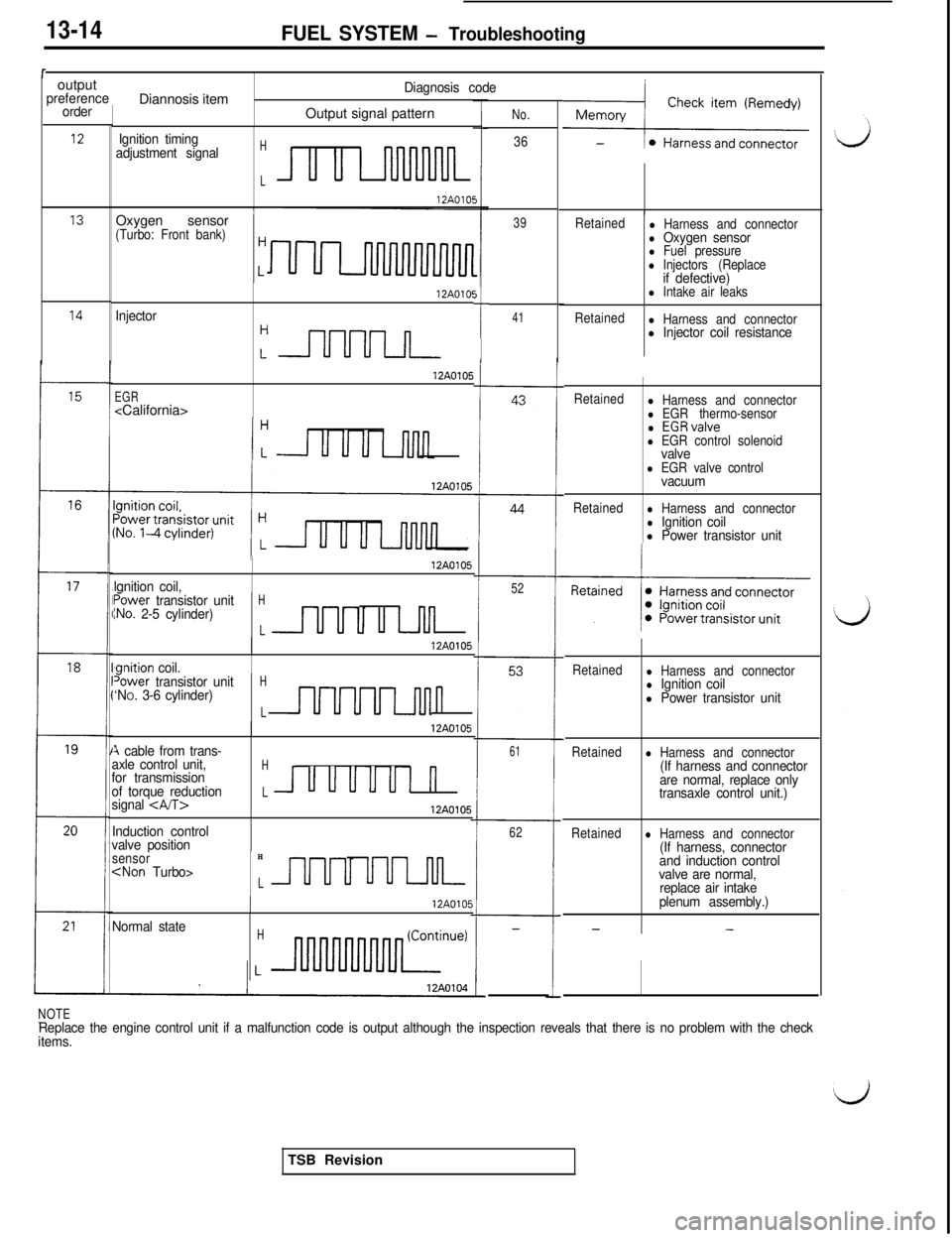
13-14FUEL SYSTEM - Troubleshooting
routput
preference
order
7Diannosis item
Diagnosis code
IOutput signal patternNo.
36
39
121 Ignition timing
adjustment signalH
L
13Oxygen sensor ’(Turbo: Front bank)HRetainedl Harness and connectorl Oxygen sensorl Fuel pressurel Injectors (Replaceif defective)l Intake air leaks
Retained
l Harness and connectorl Injector coil resistance
5
I--
Injector12AOlO!
:nnnn
EGR
12A0105
14
41
Retainedl Harness and connectorl EGR thermo-sensorl EGRvalvel EGR control solenoidvalvel EGR valve controlvacuum
Retainedl Harness and connectorl Ignition coill Power transistor unit
16
lqnition coil,
12A0105
52power transistor unitINO. 2-5 cylinder)H
Lu Lnll
‘qnition coil.
12AO105
18Retainedl Harness and connectorl Ignition coill Power transistor unit
Retainedl Harness and connector(If harness and connector
are normal, replace only
transaxle control unit.)
Retainedl Harness and connector(If harness, connector
and induction control
valve are normal,
replace air intake
plenum assembly.)
--
Tower transistor unitH‘NO. 3-6 cylinder)
Ln
12A0105
A cable from trans-
axle control unit,Hfor transmission
of torque reductionLUUUUUI n
signal 12A0105
Induction control
valve position
61
62
sensorH
12A0105
Normal stateH-
NOTE-Replace the engine control unit if a malfunction code is output although the inspection reveals that there is no problem with the check
items.TSB Revision